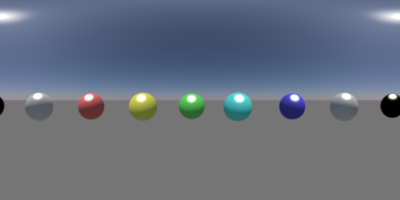The stereo spherical camera is primarily useful for Virtual Reality (VR) applications. It can render stereoscopic panoramas in various different modes.
立体球面摄像机主要用于虚拟现实(VR)应用。它可以在不同的模式下生成立体全景图。
How to use
如何使用
Please use this link for information on how to turn a camera into a stereo spherical camera.
请使用此链接获得如何将相机变成立体球面相机的信息。
Parameters
参数
The stereo spherical camera's Mode setting determines the image layout. "Side by side" means that the left and right eyes are going to be placed horizontally next to each other. "Top bottom" means the images will be placed on top of each other and, finally, you can choose to render the left and right eyes separately. For the separate left/right eye rendering, you'd need to configure your 3d app to render in two passes to get both images.
立体球面相机的模式设置决定了图像布局。“肩并肩”的意思是左眼和右眼将水平放置在一起。“ Top bottom”意思是将图像放置在彼此之上,最后,你可以选择分别渲染左眼和右眼。对于单独的左/右眼睛渲染,您需要配置您的3d 应用程序两次渲染,以获得两个图像。
The stereo spherical camera also has an eye separation setting which determines the distance between the left and right eye. The separation value is in scene units so it depends on your scene's representation of a unit (meters, centimeters, inches, etc).
立体球面相机还有一个眼睛分离设置,确定了左眼和右眼之间的距离。分离值是在场景单位,所以它取决于你的场景的表现单位(米,厘米,英寸等)。
By default, the stereo spherical 'eyes' look straight ahead. The focus distance setting allows the eyes to slightly rotate and focus at a particular distance from the camera's position.
默认情况下,立体球形眼睛直视前方。焦距设置允许眼睛在距离相机位置特定的距离上轻微旋转和聚焦。
The stereo spherical camera also has horizontal and vertical FOV settings.
立体球面相机也有水平和垂直视场设置。
To demonstrate the effect of the stereo spherical camera, we'll use the following reference scene. The camera is pointing towards the green sphere. The red sphere is 90 degrees to the left of the camera and the blue sphere is 90 degrees to the right. The black sphere is exactly behind the camera.
为了演示立体球面相机的效果,我们将使用下面的参考场景。照相机正对着那个绿色的球体。红色的球体在照相机左侧90度,蓝色的球体在右侧90度。黑色的球体正好在照相机的后面。
Below we show the effect of a stereo spherical camera using the different modes.
下面我们展示了使用不同模式的立体球面相机的效果。
For these examples, we used the default 360 degree horizontal and 180 degree vertical FOV settings. The "Side By Side" image was rendered with a 4:1 aspect ratio. The "Top Bottom" with a 1:1 aspect and the "Left Only" and "Right Only" images with a 2:1 aspect ratios.
对于这些例子,我们使用默认的360度水平和180度垂直视场设置。“肩并肩”图像渲染为4:1的纵横比。“顶部底部”与1:1的方面和“只有左”和“只有右”的图像与2:1的方面比例。
These choices were made to produce non-squashed results. Please note that some VR applications might expect different image aspect ratios!
这些选择是为了产生非压缩的结果。请注意,一些虚拟现实应用程序可能会期望不同的图像纵横比!
If the horizontal and vertical FOVs were adjusted, the aspect rations should also be adjusted. For example, if we used a 180 degree horizontal FOV (i.e. the "front hemisphere"), the aspect ratios should be 2:1, 1:2 and 1:1 for "side by side", top bottom" and "left/right only" respectively.
如果调整了水平和垂直视野,也应该调整视野比例。举例来说,如果我们使用180度的水平视野(即「前半球」) ,高宽比应分别为2:1、1:2及1:1,分别代表「并排」、「上下」及「只有左/右」。
Side by Side
肩并肩
Top Bottom
顶部和底部
Left Only
只有左边
Right Only
只有右边







赶快留个言打破零评论!~